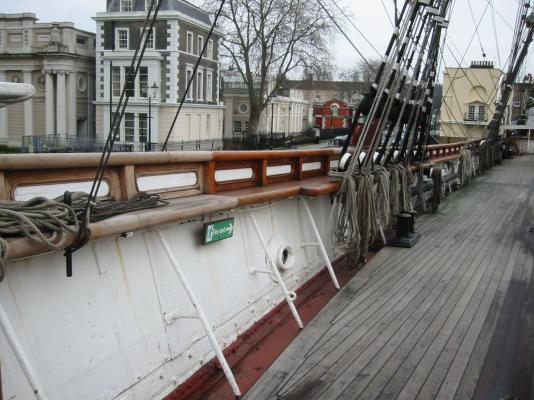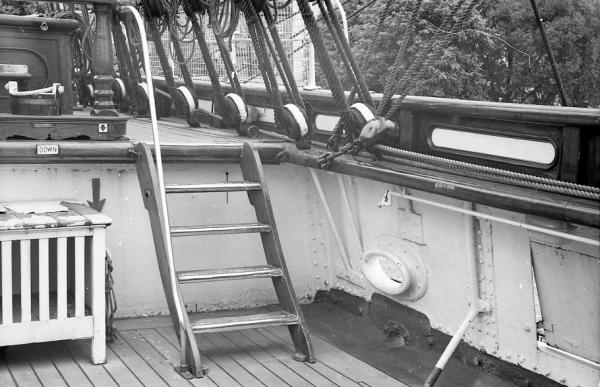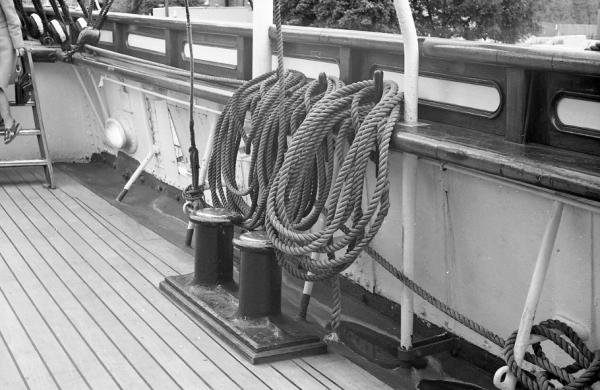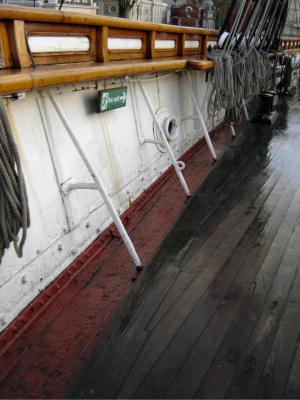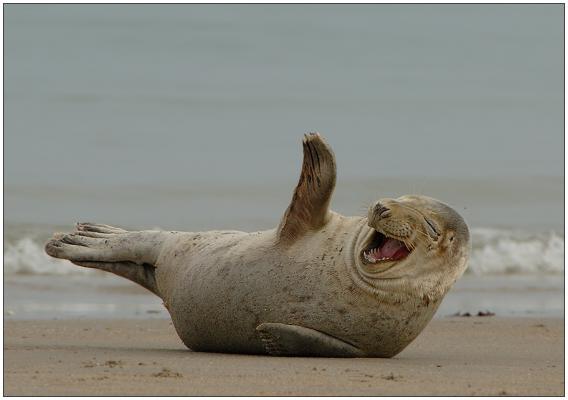-
Posts
86 -
Joined
-
Last visited
Content Type
Profiles
Forums
Gallery
Events
Everything posted by Lou van Wijhe
-
Luca, It all depends which period you want to depict. The load line during the tea runs on China was higher than during the wool runs on Australia. I can get you the exact figures but I need to go out for a few hours. When I get back, I'll look it up. Lou
- 121 replies
-
- cutty sark
- artesania latina
-
(and 1 more)
Tagged with:
-
Hi Luca, Cutty Sark's hull lines are complex and very typical of her. Your model shows these lines very well! Lou
- 121 replies
-
- cutty sark
- artesania latina
-
(and 1 more)
Tagged with:
-
Marc, The real Cutty Sark had damage to her masting several times in her active life. So, we can always say we're also imitating that! Lou
- 525 replies
-
- cutty sark
- mantua
-
(and 2 more)
Tagged with:
-
All masting and rigging that is true to scale, like yours, is vulnerable. Should you have the Cutty Sark book by Longridge, do consult the first pages of Chapter X in Part 2 - Hints on Rigging. Should you not have the book, I could upload these 6 pages (I'm sure Longridge won't mind). Lou
- 525 replies
-
- cutty sark
- mantua
-
(and 2 more)
Tagged with:
-
It's a whole new experience to see a ship model grow at such a fast pace. Maybe I should also publish my build log only after my Cutty Sark model is ready. On the other hand, you then would have to wait till 2020 (or beyond) and not everyone might still be around then. After all, I started researching her in the nineteen fifties... Lou
- 222 replies
-
- gorch fock
- barque
-
(and 2 more)
Tagged with:
-
Luca, The 2 b/w pictures are from a series I uploaded to Microsoft's OneDrive. The colour picture is made and sent to me by the ship's curator. I found another one, also by her, that shows why there might be no bent stanchion after the fore mooring port, i.e. there seems to be a clear run from the mooring port, under the stanchion to the bollards: Of course, there hasn't been a mooring cable on the ship since the nineteen fifties, so there may have been a bent stanchion after the fore mooring port as well, as described by Longridge, that was later replaced by a standard one. But do as you like, it's your ship! Lou
- 121 replies
-
- cutty sark
- artesania latina
-
(and 1 more)
Tagged with:
-
Luca, On the fore side of the after mooring port is indeed one stanchion, port and starboard, that is bent backwards and has no horizontal spur: These bent stanchions are formed this way to give a clear run for the mooring cable to the bollards: However, I cannot remember having seen a similar arrangement on the after side of the fore mooring ports and in fact there isn't such a setup at this moment: As Nenad said, there may have been changes over time. When Longridge inspected the ship in the nineteen thirties, the palms of the deadeye shanks were f.i. riveted to the bulwark plating. This must have been a repair job because normally they should have been riveted to the sheer strake, which is a safer fixture but the sheer strake may not have been accessible because it was covered in cement at that time. Lou
- 121 replies
-
- cutty sark
- artesania latina
-
(and 1 more)
Tagged with:
-
Bob, A former colleague of mine asked his boss "What can I do for you at your retirement party?" His boss answered "You can play me Red Sails in the Sunset on a saxophone." My colleague borrowed a saxophone, practised for 4 months and played the tune at the party, with great success. It was the only tune he could play and he never touched a saxophone again. There is still time, brother. Lou
-
Hi Sailcat! Good to see you back! Although "back in the saddle" might not be such a good idea, considering your injury. Hope everything turns for the better, humans appear to be vulnerable beings... Lou
- 237 replies
-
- cutty sark
- revell
-
(and 2 more)
Tagged with:
-
Bob, I made the flags, including the Red Duster, myself, using the method described here. But by searching the Internet you can also find a lot of shops where you can order ready-made ones, like this shop. I'm a bit late in responding, but being the same age you'll certainly understand how busy pensionados are. Lou
-
Zapon lacquer is often used to protect metal parts from oxidation and tarnishing. I never used it myself but I once read that you have to be careful when applying it with a brush as you might enclose tiny air bubbles. Spraying is better, as Brian C said. Zapon lacquer is very well known and available world-wide, presumably also in Australia. Lou
-

Cutty Sark by NenadM
Lou van Wijhe replied to NenadM's topic in - Build logs for subjects built 1851 - 1900
Good question, using flux is essential.- 4,152 replies
-
- cutty sark
- tehnodidakta
-
(and 1 more)
Tagged with:
-

Cutty Sark by NenadM
Lou van Wijhe replied to NenadM's topic in - Build logs for subjects built 1851 - 1900
Even in Sotsji they don't have enough snow! And in Britain they have too much water. Everything is in disorder... Lou- 4,152 replies
-
- cutty sark
- tehnodidakta
-
(and 1 more)
Tagged with:
-
I'll follow your build log with great interest, Nils! The P-liners were very impressive ships. Lou
-

Cutty Sark by NenadM
Lou van Wijhe replied to NenadM's topic in - Build logs for subjects built 1851 - 1900
- 4,152 replies
-
- cutty sark
- tehnodidakta
-
(and 1 more)
Tagged with:
-

Cutty Sark by NenadM
Lou van Wijhe replied to NenadM's topic in - Build logs for subjects built 1851 - 1900
Nenad, Wooden decks were never painted, it would make them dangerously slippery. The colour aspect changes whether deck planks are dry or wet, going from grayish when dry to dark brown when wet. Of course, you can give the deck any colour you like, it's your ship! Lou- 4,152 replies
-
- cutty sark
- tehnodidakta
-
(and 1 more)
Tagged with:
-

Cutty Sark by NenadM
Lou van Wijhe replied to NenadM's topic in - Build logs for subjects built 1851 - 1900
Nenad, The wooden decks themselves were never painted. Only the metal waterways (like other iron parts) were painted with a red/brown oxide paint, which was originally covered with cement (thus grayish coloured). In 1994 the cement was removed from the waterways in order to allow shotblasting of waterways and bulwarks before repairs were carried out. It was then decided to keep the waterways painted, and not to re-cement them. I don't know if they still have this red/brown paint on them but personally I like this colour better than gray. Lou- 4,152 replies
-
- cutty sark
- tehnodidakta
-
(and 1 more)
Tagged with:
-
Thanks for the review, Bob. The rope walk looks well designed but practical experience is important. Looking forward to further impressions. Lou
- 26 replies
-
- Ropewalk
- Linen Thread
-
(and 1 more)
Tagged with:
About us
Modelshipworld - Advancing Ship Modeling through Research
SSL Secured
Your security is important for us so this Website is SSL-Secured
NRG Mailing Address
Nautical Research Guild
237 South Lincoln Street
Westmont IL, 60559-1917
Model Ship World ® and the MSW logo are Registered Trademarks, and belong to the Nautical Research Guild (United States Patent and Trademark Office: No. 6,929,264 & No. 6,929,274, registered Dec. 20, 2022)
Helpful Links
About the NRG
If you enjoy building ship models that are historically accurate as well as beautiful, then The Nautical Research Guild (NRG) is just right for you.
The Guild is a non-profit educational organization whose mission is to “Advance Ship Modeling Through Research”. We provide support to our members in their efforts to raise the quality of their model ships.
The Nautical Research Guild has published our world-renowned quarterly magazine, The Nautical Research Journal, since 1955. The pages of the Journal are full of articles by accomplished ship modelers who show you how they create those exquisite details on their models, and by maritime historians who show you the correct details to build. The Journal is available in both print and digital editions. Go to the NRG web site (www.thenrg.org) to download a complimentary digital copy of the Journal. The NRG also publishes plan sets, books and compilations of back issues of the Journal and the former Ships in Scale and Model Ship Builder magazines.



